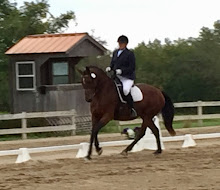When I think about balance I think about emotional balance, longitudinal balance and lateral balance. They are all very important and as riders we cannot forget any of them.
The earliest training starts out with emotional balance. It is very common for horse owners to play with their foals and maybe hold them until they relax and then pet them and release them. This is soft resistance but teaches the foal to calm itself and relax without having to break free and run off. When we ride them as adult horses - riding is soft resistance as well. The lessons the foal learns as a baby are invaluable to them as adult horses. We also teach our foals to lead, we place a rope arround their butt and ask with the halter but they learn to lead behind their mothers and then on their own. This is also soft resistance. We take the time to teach our foals to allow us to touch and pet them all over. We introduce them to picking up their feet and allowing us to pick them out and trim them. These are all very important lessons.
We maintain these lessons as the foal grows into an adult horse. As a young adult (3 years) we expand on the ground work and improve our communication with our horses. There are many folks who have written many books about their theories about ground work. There are many variations but the mechanical technique is not the most important it is the application of the groundwork that really makes the most difference to the horse. The basics the horse needs to understand on the ground is to move away from pressure, to move through tight spaces and be o.k. with it, to come forward and back away from you when asked. To be willing to explore toys or unknown objects and lean to calm themselves even if the object scares them. At this point we are ready to start the riding. The saddle and bridle are a part of the unknown objects. Getting used to girth pressure is also an unknow for the young horse that needs to be addressed.
At this point you are ready to ride your young horse. Riding is maybe a loose term. Placing pressure in the saddle and retreating may be all that is done on the first day. Gradually moving towards placing weight on the young horse is the direction you want to go in. Once the horse allows you to sit on it we then ask it to move forward. Forward may not look like what you are doing. Riders usually over bend the horses neck and ask it to move sideways off their leg. This disengages the horse and helps him understand he can move with the least amount of risk to the rider. I say this because in this way of traveling, the horse is least likely to be able to dislodge the rider. If the horse stays relaxed, he is then allowed to travel in a looser circle which looks more like riding forward. The earliest riding reminds the horse to move away from pressure. They have already learned this lesson on the ground. This is emotional balance in the earliest stages.
As the horse progresses, being fair to the horse maintains the emotional balance you have worked so hard to achieve. The horse gains confidence as we show them how to keep their balance longitudinally and laterally. Longitudinal and lateral balance become intertwinded with emotional balance from here on out.
Some horses are muscular but not so flexible, others are flexible but not strong. Once in a while you are lucky enough to have a horse that is both flexilbe and strong. A strong horse benefits from lateral movements like leg yeilding, shoulder-in, haunches in and half pass. A flexible horse benefits from up and down transitions. Transitions from the walk to the trot and the trot to the canter and the canter to the walk. The flexible horse also benefits from tansitions within the gait like working trot to legthening trot and back.
One of the most common mistakes I see is a young horse who has progressed from the beginning stages of riding to basic walk trot and canter. The rider is doing quite well and then the horse stresses a bit and either shies or tenses its back. The rider then immediately disengages the horse. The problem is that the disengagement is an aggressive manuver that takes the horse off balance. The disengagement that helps teach the beginning horse now scares the horse and takes him off balance. The young horse should be able to make a mistake and not be disengaged as a result. The young horse needs to trust the rider will help the balance, not panic and totally undo the balance. Longitudinal balance is needed if we as riders are going to ask our horses to walk trot and canter. The optimal bend for good longitudinal balance is a slight bend throuout the whole body including the neck when it is needed. This translates into no more than 1" of inside flexion in the neck. More than that and the rider looses the shoulder to the outside and compromises longitudinal balance.
All horses I train learn to spiral in and out on a circle as well as leg yeild. This helps make the horse easier to direct. For the muscular horse it loosens their muscles and begins to improve the gaits. For the flexible horse it helps them learn to coordinate their body parts and get them going in a unified direction.
Protect the willingness to move forward and sideways on the horse without resorting to disengagement and you will build confidence and trust through emotional, longitudinal and lateral balance.
Have a great ride every day!
Sunday, May 1, 2011
Subscribe to:
Post Comments (Atom)

No comments:
Post a Comment
Note: Only a member of this blog may post a comment.